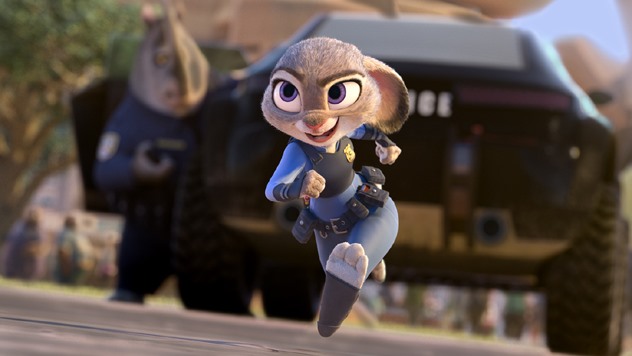The opening scene of Disney’s latest sees a young rabbit put on a school play about how the anthropomorphic world the characters live in has evolved from a prey-predator scenario into its present day human(e), harmonious community. Thus, we gain immediate insight into the subtle dynamics that define the universe of Zootropolis, which is not just another animated film about talking animals but blends genuine intuition in its incisive screenplay.
The film’s protagonist, Judy Hopps (Ginnifer Goodwin), is a bunny who, in spite of her small stature and humble upbringings, wants nothing more than to become a cop. Her farmer parents, protective and caring but somewhat naïve, want her to be realistic in her career choices and discourage her from embarking on her hazardous dreams. Determined nonetheless, Judy goes to police training academy and uses her natural abilities of bounciness and flexibility to her advantage, eventually graduating first in her class. She then moves from her rural home to the exciting city of Zootropolis.
The gorgeous animation of Zootropolis is richly textured. Made up of various districts (A mini-metropolis devoted to rodents, for example, provides the setting for a thrilling chase sequence), the design and liveliness of the city’s design and its population of colourful, quirky animal characters is visually enticing for adults and kids alike. Nate Torrence as the chubby cheetah Officer Benjamin Clawhauser and Tommy Chong’s Yax, a hippie yak, provide two particularly endearing supporting characters.
Once in the city, Judy struggles to gain the respect and authority she had in the academy, particularly from the chief of police, Bogo (Idris Elba). She soon meets Nick Wilde (Jason Bateman), a sneaky, smart-talking hustler fox who she becomes determined to catch out. However, when a number of mammals living in Zootropolis go mysteriously missing, Judy gets a chance to prove her worth and she enlists Nick to help her crack the case. So begins a classic crime-detective narrative arc which eventually develops into something greater as the pair’s investigation reveals the fissures and frictions that are inherent to the apparently flawless city.
Zootropolis is undoubtedly Disney’s most thought-provoking film in a while (leaving aside Pixar’s output). It’s a surprise to find it sneaks up on you, and that you find yourself thinking about for days after viewing. Its subtle cultural references and biting social commentary demand multiple viewing to work through its multi-layered content. There is something perceptively timely and yet timeless in its pointed narrative about prejudice and small-mindedness.
At the same time, it is probable that this more mature content will be lost on younger audiences, and one wonders whether the film’s colourful setting and animal designs will be enough to entertain and keep very young viewers attentive, particularly given the relatively complex storyline involved. Moreover, with the gravity of the subject matter and so much plot, there are not as many laugh-out-loud moments as one would like (although I defy anyone to not chuckle at one of the film’s standout scenes, which involves sloths, suffice to say). Still, the film delivers a worthy moral message that both young and old could use a reminder of from time and time.

